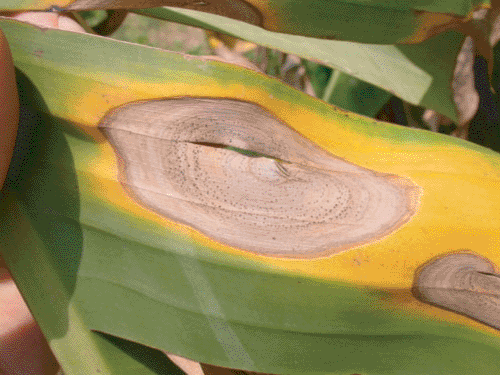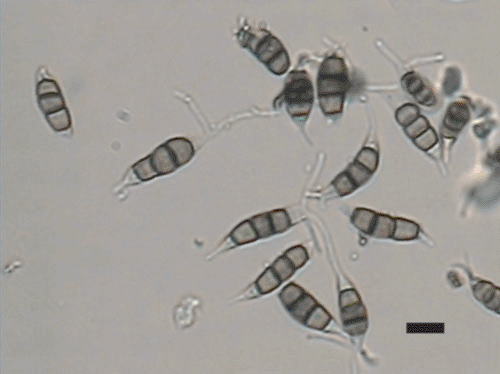First report of plantain zonate leaf spot caused by Pestalotiopsis menezesiana in China
S. L. Huang A D , B. Yan B , J. G. Wei C , W. H. Yan A , Z. L. Cen A and T. Yang BA Plant Protection Institute, Guangxi Academy of Agricultural Sciences, Nanning 530007, Guangxi, China.
B College of Agriculture, Yangtze University, Jingzhou 434025, Hubei, China.
C College of Agriculture, Guangxi University, Nanning 530005, China.
D Corresponding author. Email: silianghuang@126.com
Australasian Plant Disease Notes 2(1) 61-62 https://doi.org/10.1071/DN07025
Submitted: 21 February 2007 Accepted: 29 March 2007 Published: 11 April 2007
Abstract
Plantain zonate leaf spot, caused by Pestalotiopsis menezesiana, was found for the first time in China on a plantation at Jinling town of Nanning city, Guangxi province in 2005. The fungus was isolated and pathogenicity confirmed. The fungus was sensitive to prochloraz, iprodione, thiabendazole and triazole fungicides in vitro. Pathogenicity tests showed that the pathogen could infect banana cultivars (Musa AAA) as well as plantain (Musa AAB) under artificial inoculation conditions. However, the disease could only be found on the leaves of plantain in the fields. This is the first record of Pestalotiopsis menezesiana on plantain in China.
Plantain (Musa paradisaca) is an important subtropical crop in China where ~3800 ha2 of plantain is cultivated. Guangxi is one of the largest plantain-producing areas in the country. In southern Guangxi, plantain cultivation is considered to be an effective way of increasing the incomes of farmers because of the higher prices of its fruits in the domestic markets than other crops. As the cultivation area increased, diseases became a major constraint for plantain production. In recent years, a new disease was found on plantain leaves in the plantations in Jinling town of Nanning city, Guangxi, China. A study on the identification and characterisation of the causal organism of the disease was carried out. The pathogen infected through the wounded sites of plantain leaves. Water-soaked symptoms appeared first. The infected site developed into a black–brown lesion. In the later stage of infection, the diseased area turned into an elliptical or irregular shaped grey lesion with a golden yellow margin (Fig. 1). The characteristic concentric arrangement of Pestalotiopsis-type acervuli was frequently observed on the lesions. The fungus produced acervuli on potato dextrose agar (PDA) plates.

|
Conidia were clavate-fusiform, straight or slightly curved, 5-celled, slightly constricted at the septa, 20–27.5 × 6.3–7.5 μm (av. 22.8 × 6.6 μm); three median cells of conidia were versicolorous, thick walled, 12.5–17.5 μm (av.14.5 μm) in length, the two upper cells fuliginous and the lowest cell olivaceous-brown; the remaining two sideward cells hyaline or subhyaline, relatively thin walled; apical cell with two to four cellular appendages arising proximately at the apex; appendages hyaline, filiform, unbranched, nearly straight, borne approximately at right angles to the main axis of the conidium, 9–24 (av. 15.5) μm long; the basal cell with a single, hyaline, simple appendage, 2.5–6.3 (av.4.8) μm in length (Fig. 2). The morphological characteristics of the fungus agree with that of Pestalotiopsis menezesiana (Bissett 1982). Syptomatology, morphology of the fungus and pathogenicity tests confirmed that the fungus associated with plantain crop in Guangxi province was the casual agent of the disease. A dried culture of this fungus has been deposited in the Herbarium Mycologicum Instituti Microbiologici, Academiae Sinicae, Beijing.

|
The growth temperature range for the fungus was 10–34°C with 25°C the optimum. Conidia were produced at 13–28°C. The most conidia were produced at 22°C. Growth occurred over the range pH 3.0 to 12.0. However, pH 4–5 was more suitable for its growth. The fungus produced more conidia at pH 5.0–7.0. Ammonium nitrate and ammonium sulfate could be used as the nitrogen source for its growth, but potassium nitrate, L-histidine, glycine, alanine, L-lysine and urea could not be used for the growth. The fungus was sensitive to prochloraz, iprodione, thiabendazole and triazole fungicides in vitro. Although the pathogen could infect banana cultivars (Musa AAA) as well as plantain (Musa AAB) under artificial inoculation conditions, the disease could only be found on the leaves of plantain under field conditions.
Pestalotiopsis menezesiana was reported as the pathogen causing diseases of Vitaceae plants (Bissett 1982; Ling et al. 1999). Pestalotiopsis palmarum was found as one of the several dominant endophytes on Musa acuminate (Brown et al. 1998). Pestalotiopsis chethallensis and P. versicolor were recorded on Musa spp. (Prakash and Singh 1975; Sohi and Prakash 1978). Pestalotiopsis disseminate was reported as another pathogenic species on Musa (Guba 1961). This is the first record of P. menezesiana on plantain crop in China.
Bissett J
(1982) Pestalotiopsis menezesiana on greenhouse plantings of Cissus rhombifolia with notes on related fungi occurring on Vitaceae. Canadian Journal of Botany 60, 2570–2574.

Brown KB,
Hyde KD, Guest DI
(1998) Preliminary studies on endophytic communities of Musa acuminate species complex in Hong Kong and Australia. Fungal Diversity 1, 27–51.

Ling XU,
Kusakari S, Hosomi A
(1999) Postharvest disease of grape caused by Pestalotiopsis species. Annals of the Phytopathological Society of Japan 65, 305–311.

Prakash OM, Singh SJ
(1975) Pestalotiopsis versicolor—A new spot disease of banana. Phytopathological Notes 28, 265–266.

Sohi HS, Prakash OM
(1978) A new species of Pestalotiopsis on banana. Indian Phytopathology 30, 252–254.



